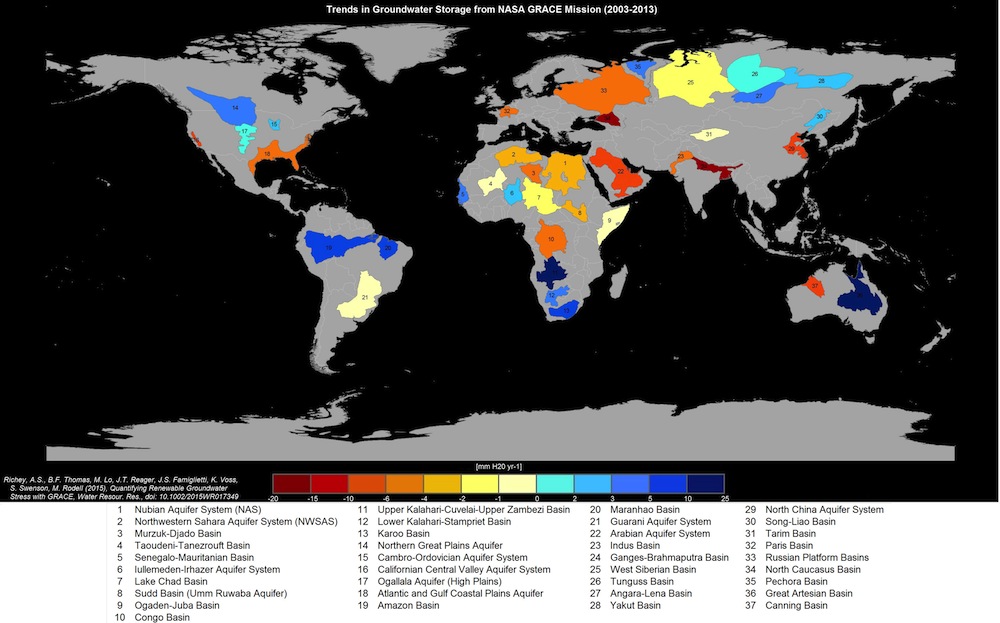Earth's Groundwater Basins Are Running Out of Water

One-third of Earth's largest groundwater basins are under threat because humans are draining so much water from them, according to two new studies. What's more, researchers say they lack accurate data about how much water remains in these dwindling reservoirs.
The studies found that eight of the world's 37 biggest aquifers are "overstressed," meaning not enough water is replenished to offset the usage. Topping the list of overstressed aquifers is the Arabian Aquifer System, located beneath Yemen and Saudi Arabia, from which 60 million people draw their water.
"What happens when a highly stressed aquifer is located in a region with socioeconomic or political tensions that can't supplement declining water supplies fast enough? We're trying to raise red flags now to pinpoint where active management today could protect future lives and livelihoods," Alexandra Richey, a graduate student at the University of California, Irvine, and lead author of both studies, said in a statement. [Earth in the Balance: 7 Crucial Tipping Points]
The researchers used data from NASA's Gravity Recovery and Climate Experiment (GRACE) satellites, twin probes that make precise measurements of changes in Earth's gravity. These gravity perturbations are influenced by changes in mass on the planet, driven by how much water has been lost.
The studies used data collected between 2003 and 2013. In addition to the Arabian Aquifer System, the most taxed aquifers are located in the world's driest regions, the researchers found. For instance, the Indus Basin aquifer, which straddles northwestern India and Pakistan, was labeled the second-most overstressed in the world, and northern Africa's Murzuq-Diado Basin rounded out the top three.
Groundwater pumping in California's Central Valley is also rapidly depleting the state's vast aquifer system, the researchers said. This overpumping is exacerbated by the extreme drought in California, which is now in its fourth year. Currently, 99 percent of California is experiencing drought conditions, and 47 percent of the state is considered to be in "exceptional drought," according to the U.S. Drought Monitor.
"As we're seeing in California right now, we rely much more heavily on groundwater during drought," principal investigator Jay Famiglietti, the senior water scientist at NASA's Jet Propulsion Laboratory, said in a statement. "When examining the sustainability of a region's water resources, we absolutely must account for that dependence."
Get the world’s most fascinating discoveries delivered straight to your inbox.
The results of the second study were just as alarming, with researchers finding that there is little information available on how much groundwater is left in the world's largest basins. In some cases, existing estimates were based on information from decades ago, the researchers said. Adding in the GRACE measurements caused large fluctuations in the estimates. For example, the "time to depletion" for the Northwest Sahara Aquifer System was estimated at anywhere between 10 and 21,000 years, the researchers said.
"Given how quickly we are consuming the world's groundwater reserves, we need a coordinated global effort to determine how much is left," said Famiglietti, who is also an earth sciences professor at the University of California, Irvine.
To access groundwater reservoirs, it is often necessary to dig through rock layers far below the Earth's surface. In addition, drillers often don't know how deep the reservoir reaches until they dig far enough to see where the moisture is no longer available. But with the world's usable groundwater disappearing faster than it is being replenished, it is crucial to pinpoint how much water remains in the planet's aquifer systems, the researchers said.
"In a water-scarce society, we can no longer tolerate this level of uncertainty, especially since groundwater is disappearing so rapidly," Richey said.
Both papers were published online June 16 in Water Resources Research, a journal of the American Geophysical Union.
Follow Live Science @livescience, Facebook & Google+. Original article on Live Science.

Elizabeth Howell was staff reporter at Space.com between 2022 and 2024 and a regular contributor to Live Science and Space.com between 2012 and 2022. Elizabeth's reporting includes multiple exclusives with the White House, speaking several times with the International Space Station, witnessing five human spaceflight launches on two continents, flying parabolic, working inside a spacesuit, and participating in a simulated Mars mission. Her latest book, "Why Am I Taller?" (ECW Press, 2022) is co-written with astronaut Dave Williams.
